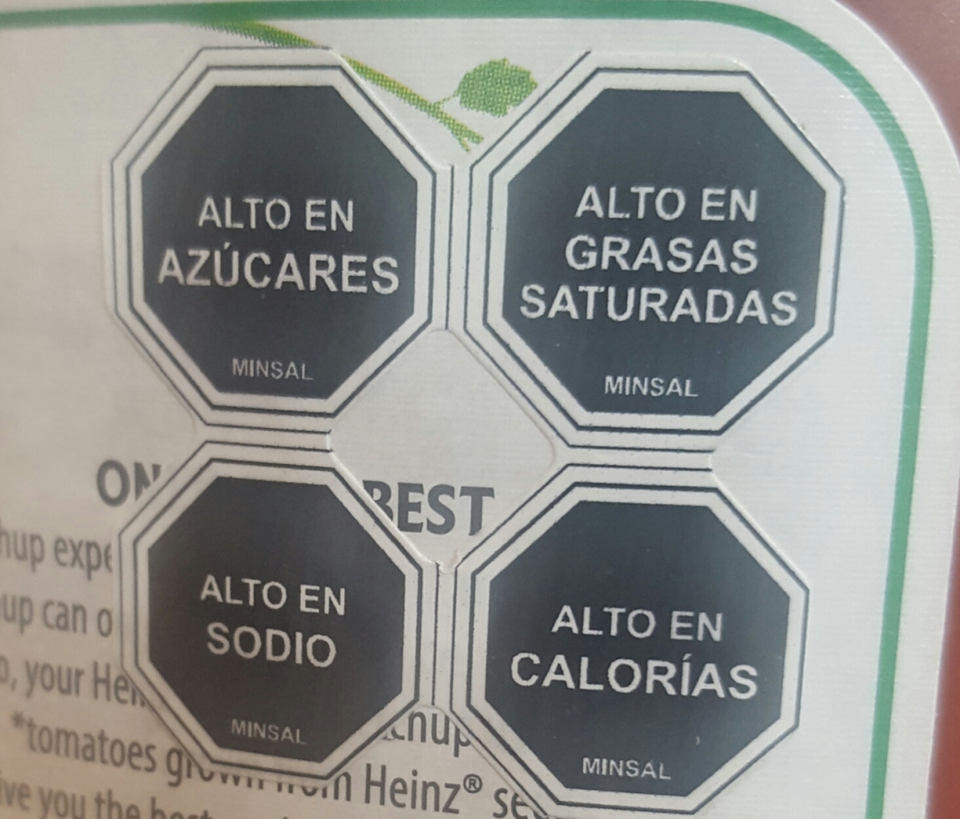Chile Black Stop Sign Food Package Labels WIKIMEDIA/AEVERAAL
Over the decades, the SAD (Standard American Diet) has been slowly trickling south. And now, just like in the U.S., a large portion (up to two-thirds) of the population is overweight and/or obese. However, unlike us in the U.S., they are doing something about it that might make food producers here less than happy.
“…countries south of the U.S. border are forcing food companies to put health warnings on their package labeling. And while the U.S. market may not require similar labeling for now, food companies shouldn’t get comfortable. Smart ones should get ahead of the game and work in earnest to make their product portfolios far healthier.
A number of Latin American governments are adopting extreme labeling – draconian graphics once reserved for cigarettes, dry cleaner bags, and rat poisoning – on snack foods, confections, packaged desserts, sweetened cereals and sugary beverages. Policymakers and public health activists worldwide are cheering these warnings, guaranteeing that they’ll spread beyond Latin America.”1
The Latin American country to hit the issue the hardest has been Chile where shoppers have seen an increasing amount of food labels with serious black stop signs warning of excessive sodium, sugar, saturated fat or calories. In fact, the unhealthiest foods could see all four stops signs.
RELATED STORY:
The movement, which began in 2016, was a response to a deepening health crisis; officials estimate that 67% of the adult population is overweight and/or obese and diabetes is on the rise. Something that one of the warnings symbols’ biggest supporters, Chilean Senator Guido Girardi, lays at the feet of food companies (who he calls “21st-century pedophiles”2). Chile no longer allows juvenile mascots on food packaging, junk food and sweets to be sold in schools or junk food advertising during prime TV hours. And, they’ve imposed an 18% sales tax on soda.
RELATED STORY:
It’s not just happening in South America, either. It seems wherever our” food” goes, the population suffers:
And other countries across Latin America have adopted or are considering similar restrictions:3
- In Peru and Uruguay, executive orders have cleared the way for the black stop signs.
- The Brazilian Health Regulatory Agency ANVISA is having informal discussions with many stakeholders about adopting a similar warning system.
- Argentinian health officials are scrutinizing what their neighbor to the north is doing.
- In 2013, Mexico imposed an aggressive soda tax that has reduced sales of sugary beverages and, according to proponents, will reduce diabetes cases by 134,000 by 2030.
Although the numbers aren’t available for what the new labels are doing to sales, “…nearly 40% of Chilean consumers say that the black octagons are influencing their purchasing decisions, and that the warnings are having an even bigger impact on their children – the consumers of the future.”4
RELATED STORY:
And that’s good news.
Now that Chile is promoting their black stop signs as a solution that could work worldwide, food and beverage companies all over the world (and especially in the U.S.) should assume that those taxes and doomsday labels will spread north. And why not? After all, it’s time for producers of cheap food to stop assuming people can’t read, don’t care, and won’t eventually rise up and take control of their health. Because it’s happening, every day, on a scale not seen in years.
“Widespread obesity is a global crisis. Despite pockets of profound malnutrition, humans today consume an average 582 more calories a day than they did in the mid-1960’s. Companies can do their part by pledging a 10% reduction in the calories in their product portfolios. They can do this imperceptibly and gradually so that consumers don’t notice. However, they must set and make known ambitious goals and then let independent parties measure and report their progress on those targets.”5
Consumers want to know what’s in their food and they want healthy options.
What’s happening with our friends in Latin America should not be ignored. Thankfully, the writing is on the wall for Big Food and Big Beverage. For far too long they have been the drivers behind our national obesity crisis. But hopefully, not for too much longer!
SOURCE:












